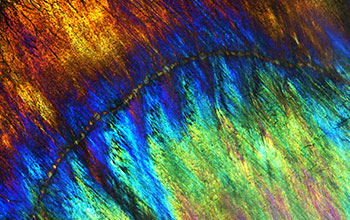Multimedia Gallery
Fish skin provides invisibility in open ocean (image 11)
Skin preparation from a lookdown fish seen under cross polarization microscopy shows birefringence in the skin. Researchers at The University of Texas at Austin studying how fish use polarized light to camouflage themselves found that some fish use microscopic structures, called platelets, in their skin cells to reflect polarized light, enabling them to seemingly disappear from their predators.
More about this image
A research team led by biologists at The University of Texas at Austin (UT-Austin) has discovered that some fish use microscopic structures called platelets in their skin cells to reflect polarized light, enabling them to seemingly disappear from their predators in the open waters of the ocean. The discovery could help materials scientists and military technologists create more effective methods of ocean camouflage.
Polarized light is made up of light waves all traveling in the same plane. Under water, light tends to be polarized, and many fish -- and sophisticated modern satellites -- have the ability to detect variations in polarized light. Molly Cummings, a professor of integrative biology in the College of Natural Sciences at UT-Austin, theorizes that fish have probably evolved a means to hide in polarized light. "If we can identify that process, then we can improve upon our own camouflage technology for that environment," says Cummings.
In an earlier study performed in Cummings' lab, researchers found that a fish called the lookdown can manipulate polarized light to its advantage. In the latest study, conducted in the open ocean, research showed that lookdowns and other fish that live in the open ocean camouflage themselves in this same manner.
For the ocean research, which took place in the Florida Keys and Curaçao and focused on five species of fish, a video polarimeter that records polarized light in real time was built, allowing researchers to essentially see polarized light as fish do. In addition, an automated, rotating platform was also built that holds a fish in place on a mirror while the polarimeter takes constant measurements. An adjustable arm holds the polarimeter 1 meter away from the fish and once started, the platform takes three minutes to spin 360 degrees, with the polarimeter recording the entire time. After each revolution, researchers would make an adjustment, such as moving the polarimeter to a slightly different angle or adjusting how much the fish was tilted, and then start the apparatus on another rotation. More than 1,500 different angular configurations were recorded for each fish, taking into account camera location, angle of the sun overhead and position of the fish.
Results of the study found that two fish from the open ocean, the lookdown and the bigeye scad, had much better camouflage in polarized light than a mirror did. These two fish also blended in better than two reef-dwelling fish and one surface-skimming fish, all of which live in environments where polarized light is not as important.
The researchers also found that the fish in the open ocean were most camouflaged when they were at "chase angles" -- the directions from which a predator would chase the fish, or from which the fish would pursue its own prey -- which extend out 45 degrees in all directions from the tail or head.
Cummings lab discovered that the fish's ability to camouflage themselves in polarized light is due to the structure of platelets within their skin cells. These microscopic structures scatter polarized light differently depending on the angle. The researchers will investigate further whether the fish can actively manipulate this ability by changing angles or perhaps adjusting the platelets within their skin.
This research was supported in part by a grant from the National Science Foundation's Division of Ocean Sciences (grant OCE 11-30793) to develop an underwater video polarimetry mooring system for the study. The funds were critical in developing the multiple sensors on the platform that allowed micro measurements of fish and camera positioning and tilt, as well as changes in depth and position relative to the sun. The funding also allowed for the ability to take continuous polarization measurements of fish and background.
To learn more about this research, see the UCF news story Fish skin provides invisibility in open ocean. (Date image taken: 2013; date originally posted to NSF Multimedia Gallery: Oct. 21, 2016) [Image 11 of 11 related images. Back to Image 1.]
Credit: Shulei Zhao
See other images like this on your iPhone or iPad download NSF Science Zone on the Apple App Store.
Images and other media in the National Science Foundation Multimedia Gallery are available for use in print and electronic material by NSF employees, members of the media, university staff, teachers and the general public. All media in the gallery are intended for personal, educational and nonprofit/non-commercial use only.
Images credited to the National Science Foundation, a federal agency, are in the public domain. The images were created by employees of the United States Government as part of their official duties or prepared by contractors as "works for hire" for NSF. You may freely use NSF-credited images and, at your discretion, credit NSF with a "Courtesy: National Science Foundation" notation.
Additional information about general usage can be found in Conditions.
Also Available:
Download the high-resolution JPG version of the image. (4.7 MB)
Use your mouse to right-click (Mac users may need to Ctrl-click) the link above and choose the option that will save the file or target to your computer.



